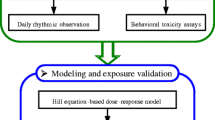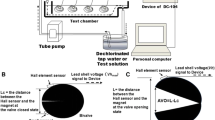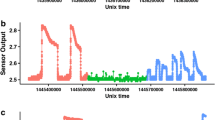Abstract
There are many bioindicators. However, it remains largely unknown which metal–bioindicator systems will give the reasonable detection ranges of bioavailable metals in the aquatic ecosystem. Various experimental data make the demonstration of biomonitoring processes challenging. Ingested inorganic arsenic is strongly associated with a wide spectrum of adverse health outcomes. Freshwater clam Corbicula fluminea, one of the most commonly used freshwater biomomitoring organisms, presents daily activity in valve movement and demonstrates biotic uptake potential to accumulate arsenic. Here, a systematical way was provided to dynamically link valve daily activity in C. fluminea and arsenic bioavailability and toxicokinetics to predict affinity at arsenic-binding site in gills and arsenic body burden. Using computational ecotoxicology methods, a valve daily rhythm model can be tuned mathematically to the responsive ranges of valve daily activity system in response to varied bioavailable arsenic concentration. The patterned response then can be used to predict the site-specific bioavailable arsenic concentration at the specific measuring time window. This approach can yield predictive data of results from toxicity studies of specific bioindicators that can assist in prediction of risk for aquatic animals and humans.
Similar content being viewed by others
References
Chen, C. J., Hsu, L. I., Wang, C. H., Shih, W. L., Hsu, Y. H., Tseng, M. P., et al. (2005). Biomarkers of exposure, effect, and susceptibility of arsenic-induced health hazards in Taiwan. Toxicology and Applied Pharmacology, 206, 198–206.
Cherry, D. S., & Soucek, D. J. (2007). Case study: Comparison of Asian clam (Corbicula fluminea) in situ testing to several nontarget test organism response to biocidal dosing at a nuclear power plant. In J. L. Farris, & J. H. van Hassel (Eds.), Freshwater bivalve ecotoxicology (pp. 285–310). New York: Boca Raton.
Dell’Omo, M. (2002). Behavioural ecotoxicology (pp. 463). New York: Chichester.
De Schamphelaere, K. A. C., Heijerick, D. G., & Janssen, C. R. (2002). Refinement and field validation of a biotic ligand model predicting acute copper toxicity to Daphnia magna. Comparative Biochemistry and Physiology Part C: Toxicology & Pharmacology, 133, 243–258.
Fergusion, J. F., & Gavis, J. (1972). A review of the arsenic cycle in natural waters. Water Research, 6, 1259–1274.
Gerhardt, A., de Bisthoven, L. J., & Schmidt, S. (2006). Automated recording of vertical negative phototactic behaviour in Daphnia magna straus (Crustacea). Hydrobiologia, 559, 433–441.
Gerhardt, A., de Bisthoven, L. J., & Soares, A. M. V. (2005). Evidence for the stepwise stress model: Gambusia holbrooki and Daphnia magna under acid mine drainage and acidified reference water stress. Environmental Science & Technology, 39, 4150–4158.
Hatano, A., & Shoji, R. (2008). Toxicity of copper and cadmium in combinations to duckweed analyzed by the biotic ligand model. Environmental Toxicology, 23, 372–378.
Huang, Y. K., Lin, K. H., Chen, H. W., Chang, C. C., Liu, C. W., Yang, M. H., et al. (2003). Arsenic species contents at aquaculture farm and in farmed mouthbreeder (Oreochromis mossambicus) in blackfoot disease hyperendemic areas. Food and Chemical Toxicology, 41, 1491–1500.
Jou, L. J., & Liao, C. M. (2006). A dynamic artificial clam (Corbicula fluminea) allows parsimony on-line measurement of waterborne metals. Environmental Pollution, 144, 172–183.
Kamo, M., & Nagai, T. (2008). An application of the biotic ligand model to predict the toxic effects of metal mixtures. Environmental Chemistry, 27, 1479–1487.
Kelly, B. C., Ikonomou, M. G., Blair, J. D., Morin, A. F., & Gobas, F. A. P. C. (2007). Food web-specific biomagnification of persistent organic pollutants. Science, 317, 236–239.
Liao, C. M., Chen, B. C., Singh, S., Lin, M. C., & Han, B. C. (2003). Acute toxicity and bioaccumulation of arsenic in tilapia Oreochromis mossambicus from blackfoot disease area in Taiwan. Environmental Toxicology, 18, 252–259.
Liao, C. M., Jau, S. F., Chen, W. Y., Lin, C. M., Jou, L. J., Liu, C. W., et al. (2008). Acute toxicity and bioaccumulation of arsenic in freshwater clam Corbicula fluminea. Environmental Toxicology, 23, 702–711.
Liao, C. M., Jau, S. F., Lin, C. M., Jou, L. J., Liu, C. W., Liao, V. H. C., et al. (2009). Valve movement response of the freshwater clam Corbicula fluminea following exposure to waterborne arsenic. Ecotoxicology, 18, 567–576.
Liao, C. M., Jou, L. J., Lin, C. M., Chiang, K. C., Yeh, C. H., & Chou, B. Y. H. (2007a). Predicting acute copper toxicity to valve closure behavior in the freshwater clam Corbicula fluminea supports the biotic ligand model. Environmental Toxicology, 22, 295–307.
Liao, C. M., Lin, C. M., Jou, L. J., & Chiang, K. C. (2007b). Linking valve closure behavior and sodium transport mechanism in freshwater clam Corbicula fluminea in response to copper. Environmental Pollution, 147, 656–667.
Lin, M. C., Liao, C. M., Liu, C. W., & Singh, S. (2001). Bioaccumulation of arsenic in aquacultural large-scale mullet Liza macrolepis from blackfoot disease area in Taiwan. Bulletin of Environmental Contamination and Toxicology, 67, 91–97.
Lin, M. C., Lin, H. Y., Cheng, H. H., Chen, Y. C., Liao, C. M., & Shao, K. T. (2005). Risk assessment of arsenic exposure from Consumption of Cultured Milkfish, chanos chanos (Forsskål), from the Arsenic-contaminated area in Southwestern Taiwan. Bulletin of Environmental Contamination and Toxicology, 75, 637–644.
Liu, C. W., Huang, F. M., & Hsueh, Y. M. (2005). Revised cancer risk assessment of inorganic arsenic upon consumption of tilapia (Oreochromis mossambicus) from blackfoot disease hyperendemic areas. Bulletin of Environmental Contamination and Toxicology, 74, 1037–1044.
Liu, C. W., Liang, C. P., Huang, F. M., Hsueh, Y. M. (2006). Assessing the human health risks from exposure of inorganic arsenic through oyster (Crassostrea gigas) consumption in Taiwan. Science of the Total Environment, 361, 57–66.
Liu, C. W., Liang, C. P., Lin, K. H., Jang, C. S., Wang, S. W., Huang, Y. K., et al. (2007). Bioaccumulation of arsenic compounds in aquacultural clams (Meretrix lusoria) and assessment of potential carcinogenic risk to human health by ingestion. Chemosphere, 69, 128–134.
National Researcher Council (NRC) (2001). Arsenic in drinking water. Washington, DC: National Academy Press.
Newton, T. J., & Cope, W. G. (2007). Biomarker response of unionid mussels to environmental contaminants. In J. L. Farris, & J. H. van Hassel (Eds.), Freshwater bivalve ecotoxicology (pp. 257–284). New York: Boca Raton.
Niyogi, S., & Wood, C. M. (2003). Effects of chronic waterborne and dietary metal exposures on gill metal-binding: Implications for the Biotic Ligand Model. Human and Ecological Risk Assessment, 9, 813–846.
Niyogi, S., & Wood, C. M. (2004). Biotic ligand model, a flexible tool for developing site-specific water quality guidelines for metals. Environmental Science and Technology, 38, 6177–6192.
Ortmann, C., & Grieshaber, M. K. (2003). Energy metabolism and valve closure behaviour in the Asian clam Corbicula fluminea. Journal of Experimental Biology, 206, 4167–4178.
Paquin, P. R., Gorsuch, J. W., Apte, S., Batley, G. E., Bowles, K. C., Campbell, P. G. C., et al. (2002). The biotic ligand model: A historical overview. Comparative Biochemistry Physiology Part C: Toxicology & Pharmacology, 133, 3–35.
Rosato, E. (2007). Daily rhythms: Methods and protocols (pp. 362). Clifton: Humana.
Santos, H. M., Diniz, M. S., Costa, P. M., Peres, I., Costa, M. H., Alves, S., et al. (2007). Toxicological effects and bioaccumulation in the freshwater clam (Corbicula fluminea) following exposure to trivalent arsenic. Environmental Toxicology, 22, 502–509.
Sebesvari, Z., Ettwig, K. F., & Emons, H. (2005). Biomonitoring of tin and arsenic in different compartments of a limnic ecosystem with emphasis on Corbicula fluminea and Dikerogammarus villosus. Journal of Environmental Monitoring, 7, 203–207.
Shaw, J. R., Glaholt, S. P., Greenberg, N. S., Sierra-Alvarez, R., & Folt, C. L. (2007). Acute toxicity of arsenic to Daphnia pulex: Influence of organic functional groups and oxidation state. Environmental Toxicology and Chemistry, 26, 1532–1537.
Tran, D., Ciret, P., Ciutat, A., Durrieu, G., & Massabuau, J. C. (2003). Estimation of potential and limits of bivalve closure response to detect contaminants: Application to cadmium. Environmental Toxicology and Chemistry, 22, 914–920.
Tran, D., Fournier, E., Durrieu, G., & Massabuau, J. C. (2004). Copper detection in the Asiatic clam Corbicula fluminea: Optimum valve closure response. Aquatic Toxicology, 66, 333–343.
Tran, D., Fournier, E., Durrieu, G., & Massabuau, J. C. (2007). Inorganic mercury detection by valve closure response in the freshwater clam Corbicula fluminea: integration of time and water metal concentration changes. Environmental Toxicology and Chemistry, 26, 1545–1551.
US EPA (2000). Technical progress report of the implementation plan for probabilistic ecological assessments: Aquatic systems. Meeting scheduled for April 6–7. Washington, DC: United States Environmental Protection Agency.
Author information
Authors and Affiliations
Corresponding author
Rights and permissions
About this article
Cite this article
Chen, WY., Liao, CM., Jou, LJ. et al. Predicting bioavailability and bioaccumulation of arsenic by freshwater clam Corbicula fluminea using valve daily activity. Environ Monit Assess 169, 647–659 (2010). https://doi.org/10.1007/s10661-009-1204-2
Received:
Accepted:
Published:
Issue Date:
DOI: https://doi.org/10.1007/s10661-009-1204-2




